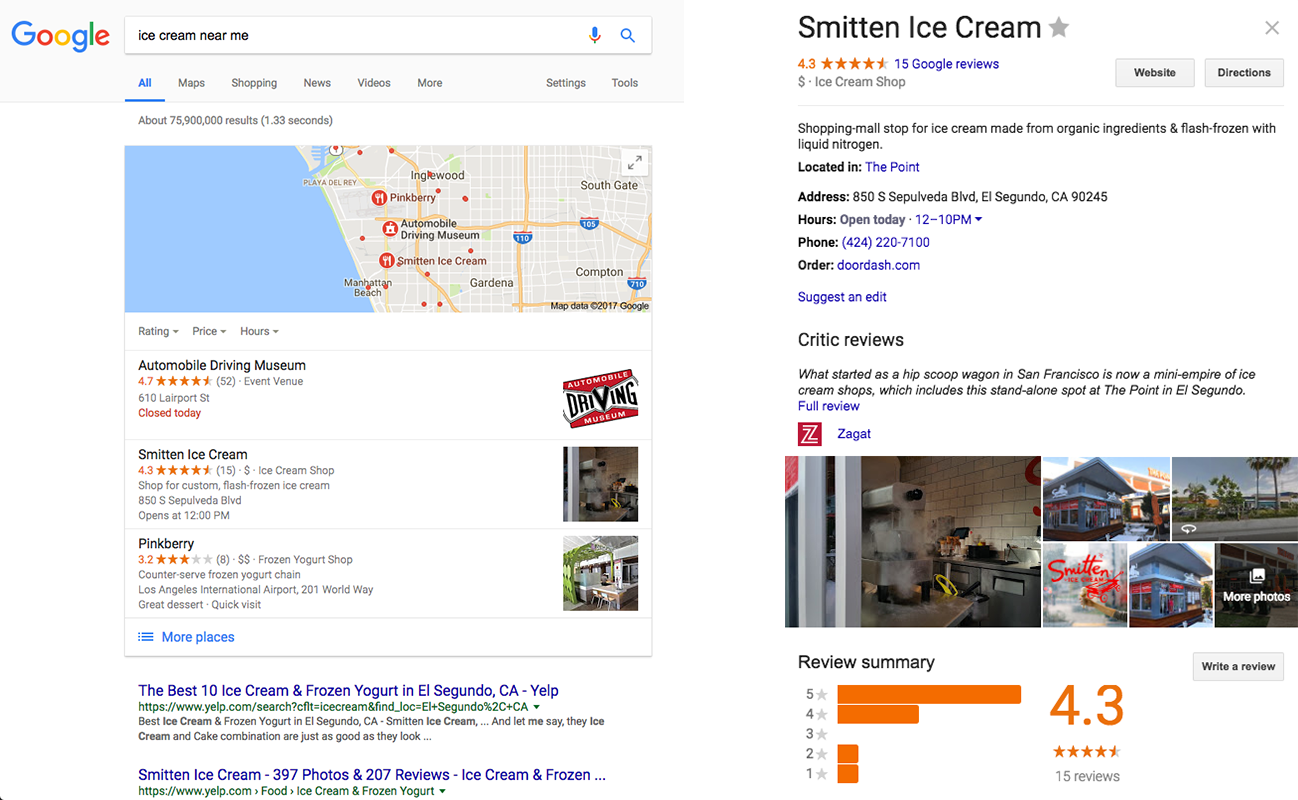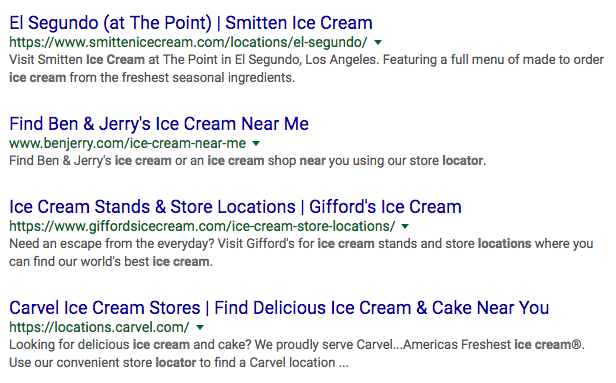As the weather warms up here in Southern California, my ice cream consumption will probably increase. And one day when I’m at the beach, I may whip out my mobile phone to Google “ice cream near me.” Situations like this are a common occurrence – Google has reported that “near me” searches have doubled since two years ago and continue to grow.
These “near me” searches, classified as “micro-moments” by Google, define the way people are searching on mobile devices in real time, in the moment. As a local business, you want to capture these consumers who have high intent to purchase your products or services. By utilizing a few local SEO tactics, you can do just that by increasing your rankings for “near me” searches that are relevant to your business.
The Anatomy Of “Near Me” Search Results
First, let’s analyze how “near me” Google search results look. Although this format may change in the future, currently at the top of results three business listings will appear in Google’s “Local Pack.” These listings are tied to Google My Business accounts, which populate business location information on Google Maps.

Below the local pack is a collection of organic results which is usually headed by popular directories, like Yelp. This adds another challenge of outranking these directories to appear nearer the top of organic search results.
Some brands successfully have the location pages and the location finder page of their website ranking for “near me” searches. As seen below, Smitten Ice Cream, Ben & Jerry’s, and Carvel’s online location pages are ranking for the search query “ice cream near me,” most likely due to the fact that the keywords used in the title tags of the location page relate to the user’s search (“Near You,” “Near Me,” and the location “El Segundo”).

This is one tactic that businesses are using to rank for “near me” searches, but this isn’t the only tactic the industry has seen that operates as a ranking factor for location-based online searches.
How To Optimize For “Near Me” Searches
There are a variety of ways you can help your website rank for “near me” searches that require both on- and off-site work.
Have A Mobile-Friendly Website
First and foremost, you want to be sure your website is mobile-friendly. “Near me” searches are more likely to be done on a mobile device because your products/services are needed by the consumer right in that moment. As such, you want to be sure your website is easy to access and use on such devices. The most effective way of making your website mobile-friendly is through responsive web design. A responsive website makes all the content of your website available in a format that fits the size and capabilities of a mobile device’s screen.
Google is now favoring mobile-friendly websites and will soon be rolling out a mobile-first index, meaning the search engine will be using factors of the mobile version of websites first in order to determine authority and, in turn, rankings.
Display Your NAP
This one is pretty straight forward: your business NAP (name, address, and phone number) should be displayed on your website. How else will online searchers and search engines know where your store is located? Your NAP information should be prominently featured on your website in a way that search engines can simply understand and pull into search results. This is usually best done by placing the NAP information in the footer of website, so it appears on every page of the site.
If your business has multiple locations, create a separate page for each location that contains NAP information for that specific location. This will allow Google to more easily recognize and index the different addresses of your locations.
Use Structured Data Markup
Getting a little more technical here, structured data markup is a way to allow search engines to more easily read, understand, organize, and display information from your website by making the data highly structured and predictable. Adding structured data markup to the NAP information on your site will allow Google to pick up on this information with greater success, thus allowing Google to recognize your business’s relevancy to valuable “near me” searches.
Google’s Structured Data Markup Helper allows you to easily create structured data code to place on your website’s backend.
Create & Manage Online Local Listings
As mentioned, Google pulls location information from Google My Business listings. Therefore, it’s important that you have a Google My Business listing set up for each of your business’s locations. NAP information on each listing should be monitored so that it remains up to date and accurate. Google My Business listings also allow you to display business location hours and photos, so be sure you’re providing as much relevant information as possible.
Beyond Google, setting up listings on sites like Yelp, Facebook, and any industry-specific directories where your address can be displayed can also help you rank for “near me” searches. NAP information across these local listing sites should be consistent to send trust signals to search engines.
Gather Online Reviews
Reviews hold a lot of weight in the world of online search. Many consumers base their purchase decisions on reviews they find for businesses across Google, Yelp, and Facebook. It’s to your advantage to be constantly asking for reviews not only to appeal to new customers online, but to influence your rankings on search engines for “near me” searches. Collecting more Google reviews can impact your business’s rankings in Google’s local pack – earning you a prime spot of visibility that stands out to people looking for your products and services nearby. And remember how Yelp listings usually appear at the top of search engine results for “near me” searches? Gathering Yelp reviews will help you to appear within these Yelp results.
Earn Geo-Targeted Backlinks
This tactic may be the most difficult, as it is highly specific, but local SEO studies have shown that it does influence “near me” search rankings. Having a high count of backlinks (links on other websites that lead to your website) with your business location’s city and state in the anchor text (the actual text being hyperlinked on a webpage) tends to correspond with higher rankings for “near me” searches.
If your website is going to be linked on another website, like that of a partner or organization you’re sponsoring, try to arrange for the anchor text of that link to read “Your Business Name – City, State.”
“Near Me” Search Success
As “near me” searches continue to grow, it’s becoming clearer what SEO strategies influence rankings. Using the six tactics explained above, you can best serve new, high-intent customers in their “micro-moments” of searching for products and services related to your business in real-time. Apply these methods and success for “near me” searches will be nearer than you think!






Responses